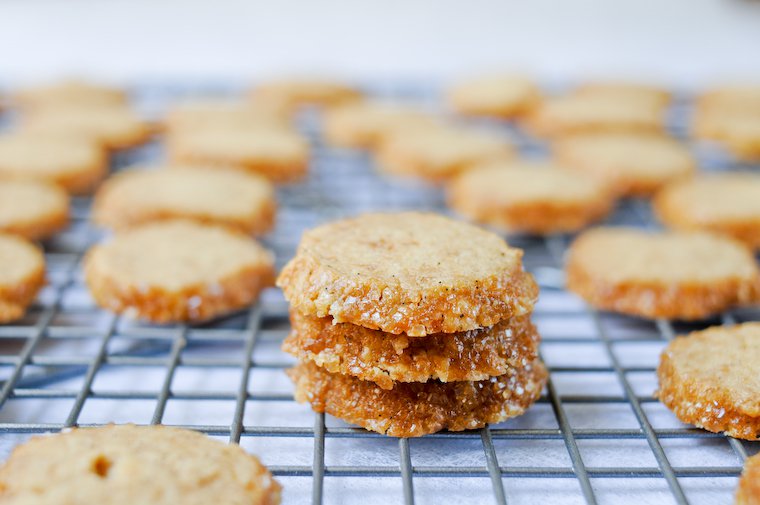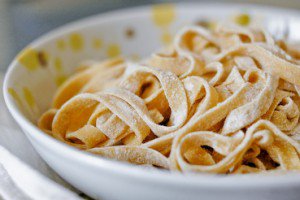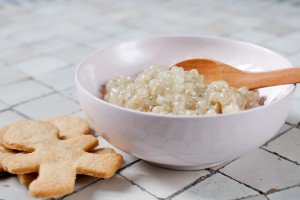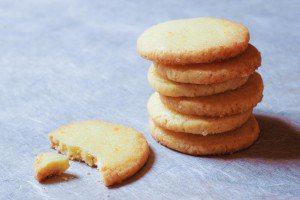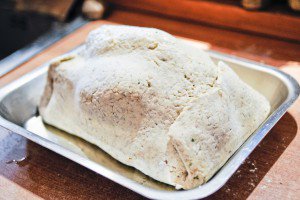Menu Fretin is a young French independent publishing house that specializes in culinary books*. Considering the teeny size of the organization, and how crazily difficult it is for an indie to carve a space for itself among the Goliaths of publishing, its book list is impressive, featuring daring projects that straddle the old and the new.
This, to me, is the perfect sablé: a crisp-then-crumbly cookie that tastes of vanilla and butter, with a touch of salt and a caramel undertone.
Menu Fretin has published such historical gems as an augmented edition of Alexandre Dumas’ Grand Dictionnaire de Cuisine, a biography of Grimod de la Reynière and other assorted texts of nineteenth-century food writing, but also new works by contemporary chefs Olivier Nasti in Kaysersberg, Juliette and Jean-Marie Baudic in Saint-Brieuc, or the twenty-six expatriated French chefs gathered in a collective called Village de chefs.
Late last year, three titles were added as part of a new collection called Menu Festin (small feast). [Update: the 11 slim volumes of the collection have now been reissued as a single book.] For each of these little books, the clever concept is to have a chef come up with a five-course menu (appetizer, first course, main course, dessert, mignardise or pre-dessert) around a particular theme, then lay out the full cooking timeline throughout the book, with a countdown from the first prep steps to the time of serving. Step-by-step pictures and check lists of tasks and ingredients round out the cook’s game plan.
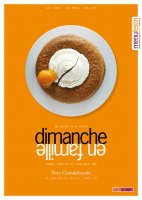 One of these books is called Dimanche en famille and is authored by Yves Camdeborde, the famous Béarnais chef who’s often credited for fathering the neo-bistro trend in Paris, where he now runs the über-popular Comptoir du Relais and the hotel it’s attached to.
One of these books is called Dimanche en famille and is authored by Yves Camdeborde, the famous Béarnais chef who’s often credited for fathering the neo-bistro trend in Paris, where he now runs the über-popular Comptoir du Relais and the hotel it’s attached to.
As the title of the book suggests, Camdeborde’s menu is for a Sunday family meal, unfolding as follows: his grandmother’s gougères (cheese puffs) as an appetizer, then a beef consommé (or broth) with foie gras ravioli, a salt-crusted chicken with chanterelles and pasta, an Armagnac-soaked savarin (a yeast-raised cake) with apricot marmalade and whipped cream, and some vanilla sablés (sandy butter cookies).
I find the entire menu appealing in a traditional way that evokes a family other than my own, a big old house somewhere south, and a table in a garden under a cherry tree. I probably wouldn’t serve it all in one go because it sounds like a lot of food, even for a Sunday, but I love that each dish helps you learn one or several techniques, and Camdeborde is generous with his tips and explanations.
The first recipe I tried is the one for sablés, as emphatically recommended by Laurent Seminel, who runs the publishing house.
Butter, sugar, flour, vanilla, salt: it looks like a classic recipe for sablés diamant (butter cookies rimmed with sugar), and it uses my preferred technique of slice-and-baking the log of cookie dough. But what makes it exceptionally successful, I think, is that it calls for a low-temperature oven (150°C or 300°F). This allows the sablés to bake gently and evenly, without coloring, while the sugar coating around the sides has time to form a caramelized crust.
And what you get is, to me, the perfect sablé: a crisp-then-crumbly cookie that tastes of vanilla and butter, with a touch of salt and a caramel undertone.
It is a treat on its own, but it works well with fruit salads and ice cream, too. We’ve been savoring this latest batch with my chocolate frozen yogurt), before I was inspired to turn the last few into miniature tartlets, with a smear of crème fraîche and a cluster of wild strawberries on top.
The recipe makes a big batch — the book says it yields eighteen cookies, but mine were bite-size and I got about fifty — so half of the dough may be frozen for on-demand sablés on a later date.
Want more sablé recipes? Take a look at these:
~ Matcha Shortbread Cookies,
~ Squeeze Cookies made with roasted flour,
~ Crisp Hazelnut and Pepper Cookies,
~ Shortbread.
~~~
* In French, the expression menu fretin means things or people of little importance; it is the exact equivalent of the English expression “small fry”. The adjective menu(e) means small, and fretin is the small fish that fishermen throw back into the water because they’re not worth the trouble.

Have you tried this? Share your pics on Instagram!
Please tag your pictures with #cnzrecipes. I'll share my favorites!
Ingredients
- 200 grams (7 ounces, or 1 cup minus 2 tablespoons) good-quality unsalted butter, at room temperature
- 70 grams (1/3 cup) sugar (I use a finely ground blond unrefined cane sugar)
- a good pinch salt
- 1 or 2 vanilla beans, depending on their size (my vanilla pods are quite fat, so I use just one)
- 250 grams (8 3/4 ounces, about 2 cups) flour
- 1 egg yolk or 3 tablespoons milk for brushing
- coarse sugar for coating (I use a large-crystal unrefined cane sugar)
Instructions
- In a medium mixing bowl, beat the butter with a spatula until creamy. Add the sugar and salt and mix them in thoroughly.
- Split the vanilla bean(s) down its (their) length and collect the seeds by scraping the insides of the bean with the dull side of a knife. Stir the seeds into the mixture. (Save the empty pods for another use -- to make vanilla sugar or vanilla oil, to infuse in milk, etc.)
- Add the flour and rub it into the butter mixture with the tips of your fingers until incorporated.
- (Although Camdeborde recommends making the dough by hand to avoid heating it, I confess I've made it in my stand mixer fitted with the paddle attachment.)
- Gather the dough into a ball without kneading. Divide into 4 pieces and roll each piece into a log, about 3 cm (1 1/4 inches) in diameter. Wrap the logs in plastic wrap or parchment paper, and place in the fridge to firm up for at least 1 hour. (Alternatively, you can freeze all or part of the logs to bake later; thaw partially at room temperature for about 1 hour before proceeding with the rest of the recipe.)
- Preheat the oven to 150°C (300°C) and line a baking sheet with a silicone baking mat or a sheet of parchment paper.
- Remove the logs from the fridge. Beat the egg yolk, if using, with a few drops of water to thin it out. Working with each log in turn, use a pastry brush to coat the log with egg yolk or milk on all sides, then sprinkle with coarse sugar until coated all over.
- Use a sharp knife to slice the logs into rounds, about 1 cm (1/3 inch) in thickness. Arrange the slices on the prepared baking sheet, leaving just a little space around the sablés -- they won't expand much.
- Bake for 30 minutes, until the dough is set in the center -- the cookies will barely color -- and the sugar is lightly caramelized on the sides. Let rest on the baking sheet for 5 minutes before transferring to a rack to cool completely. Repeat with the remaining dough.
- The sablés will keep for about a week in an airtight container at room temperature.
Notes
- I make a mean matcha variation by substituting one tablespoon green tea powder for the vanilla.
- Adapted from a recipe in Yves Camdeborde's Dimanche en famille (Menu Fretin).


